Different Types of O-Rings and Their Applications in Various Industries
Understanding O-Ring Types A Comprehensive Guide
O-rings are simple yet crucial components used in a multitude of industries, serving as seals to prevent the leakage of fluids and gases. They are circular in shape with a round cross-section and are typically made from various materials depending on their intended application. Understanding the types of O-rings available can aid engineers and technicians in selecting the right one for their specific needs.
Material Types
The most fundamental aspect of O-ring selection is the material. Different materials offer varying levels of resistance to heat, chemicals, and abrasion. Some of the most common materials include
1. Nitrile Rubber (Buna-N) Known for its excellent oil resistance, this material is widely used in automotive, aerospace, and industrial applications. It performs well in high-pressure environments and operates effectively at temperatures ranging from -40°F to 250°F (-40°C to 121°C).
2. Viton (FKM) This synthetic rubber excels in situations requiring high heat resistance and chemical stability. It is particularly effective against petroleum-based fluids and can handle temperatures as high as 400°F (204°C). Due to its properties, Viton O-rings are a preferred choice in chemical processing and aerospace industries.
3. Silicone Rubber While silicone O-rings are not as strong in mechanical applications compared to other materials, they possess excellent thermal stability and flexibility. They can operate in extreme temperature ranges, from -100°F to 500°F (-73°C to 260°C), making them suitable for food processing, pharmaceutical, and various industrial applications.
o ring types

4. EPDM (Ethylene Propylene Diene Monomer) This material is particularly resistant to weathering, aging, and ozone. EPDM O-rings are commonly used in outdoor or exposed environments, such as automotive applications and HVAC systems.
Size and Compression
O-rings come in various sizes and dimensions, with the most common defined by their inner diameter (ID) and cross-sectional thickness. Proper sizing is critical as an O-ring that is too small may not create an effective seal, while one that is too large may not fit securely in the groove. The compression set, or the amount an O-ring is compressed when placed in a gland, influences its sealing capabilities. A suitable compression ensures that the O-ring provides the necessary force against the sealing surfaces.
Applications
O-rings have broad applications across various sectors, including automotive, aerospace, oil and gas, and manufacturing. In automotive systems, they function in fuel and hydraulic systems, where preventing leaks is crucial for safety and efficiency. In the aerospace sector, O-rings are utilized in fuel seals, hydraulic systems, and even in the Space Shuttle's solid rocket boosters.
Conclusion
The selection of the appropriate O-ring type is vital to ensuring the reliability and functionality of seals in multiple applications. Considering material properties, size, and operating conditions will guide engineers in making informed decisions that enhance system performance. As technology advances, the development of new materials and designs continues to improve the effectiveness and endurance of O-rings, solidifying their indispensable role in engineering and manufacturing. Understanding these different types and their specific applications can lead to more efficient designs and longer-lasting systems.
-
Understanding Automotive Oil Seals: Essential Components for Engine and Shaft Protection
News Jul.30,2025
-
The Importance of Heavy Duty Seals in Industrial and Residential Applications
News Jul.30,2025
-
Exploring Industrial Oil Seals: From Felt Oil Seals to TTO and CFW Solutions
News Jul.30,2025
-
Essential Guide to Oil Seals: From Radial to Metal-Cased Seals for Industrial Reliability
News Jul.30,2025
-
Choosing the Right Oil Seals and Gaskets for Industrial and Automotive Applications
News Jul.30,2025
-
Cassette Seals: Durable Sealing Solutions for Harsh Environments
News Jul.30,2025
-
Understanding the Front Main Engine Seal: Purpose, Maintenance, and Installation
News Jul.29,2025
Products categories















